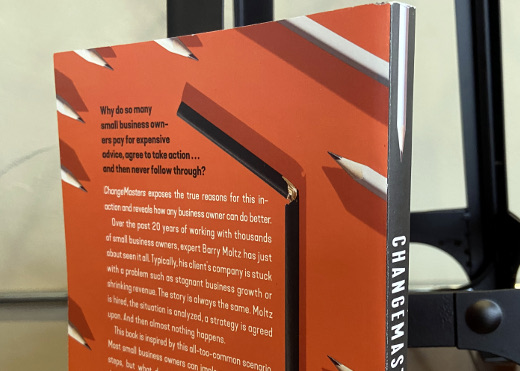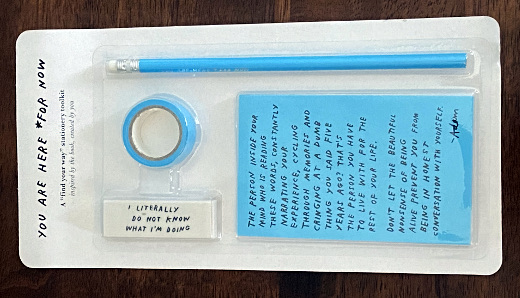My Takeaways From American Marxism
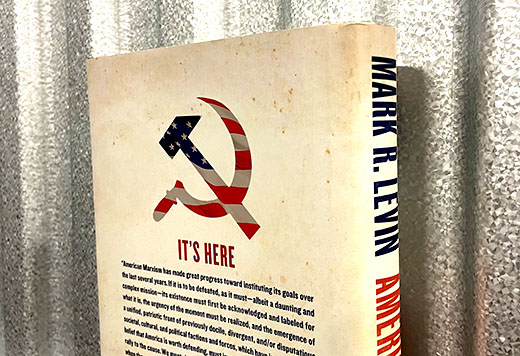
Words matter. And over the last few years I have heard words and phrases used by people describing both themselves and others in ways I haven’t heard in a long time, or ever.
One such word is Marxist, and it is one that has been both applied to oneself or others in a very broadstroke way. This is not a descriptive term I am completely unfamiliar with, yet it is one I am not completely understanding of its meaning either. So when I got a copy of American Marxism by Mark Levin for Christmas this past year, I was intrigued to read it. My hopes were that it would help me understand the 5 H’s and 1 W of the use of the descriptor.
As I read through American Marxism, I kept this personal goal in mind and do so now as I reflect on my takeaways from it.
This book is not a history on Marxism – Marxism comes from Karl Marx, a 19th century German writer and philosopher. From my experience, especially as someone who hasn’t studied him before, his philosophy is to the left of the political spectrum and is often compared with Socialism and Communism. Add the word “American” it and one can assume it applies to similar people and beliefs in the US. But rather than start from the beginning, it starts in the middle and makes assumptions of knowledge of many of the people mentioned in the book. Saying that someone is a Marxist is not a definition of the term, but inferences can be made.
Degrowth – I have never heard of this term previously, and thus was new to me. My own personal high-level definition is that it is the opposite of growth, encompassing everything from economic development to population growth. This is something in itself I may want to explore more, especially as it is presented in the context of Marxism.
I like Capitalism – Where there are both good and bad in everything we do, I personally believe that free societies where people know what’s best for them as well as free markets are the way to go and we have a robust society as a result of it. Granted not everyone shares in this, but there are many complex reasons for this.
The author of American Marxism, Mark Levin, is a conservative radio talk show host, and my guess is this book is written for his audience and not looking to reach a broader audience, similarly to other politically-oriented books I have read. As someone who doesn’t have a firm footing in one place on the political spectrum, reading American Marxism helped me understand better how some observe those who apply this term to themselves, or who don’t but others apply it to them. Where words matter, so do actions, and no matter where someone’s beliefs are, perhaps we shouldn’t focus as much on labels.
If the title of this book intrigues you then I recommend American Marxism. There were many people introduced in this book that I was not familiar with and would require more research as to their background and fully what they said beyond quotes, but it is a well-written and quick read on the topic. As I pass along all books, this one is going to someone whom I am sure the title would resonate with.
This is from The Hot Iron, a journal on business and technology by Mike Maddaloni.
Did you enjoy this? Subscribe to The Hot Iron by RSS/XML feed or Read by Email
Book Take-Aways • (0) Comments • PermalinkMy Takeaways from Firestorm at Peshtigo
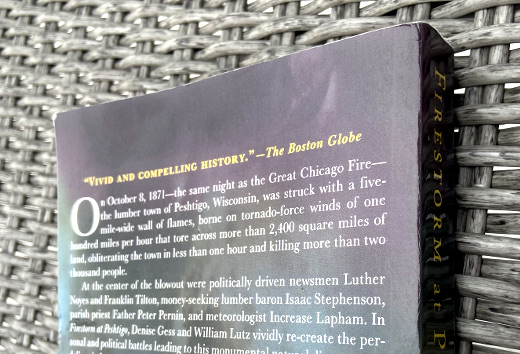
Even the most casual observer of history will know about the great fire in Chicago, Illinois in the US in 1871. From the legend of Mrs. O’Leary’s cow to the city’s destruction and rebirth, it is the stuff of legends. But do they – or you – know of a fire equally as intense that likely killed ten times as many people… just a few hours away… on the same day?
Don’t feel bad if you don’t – I didn’t either until I moved closer to where that second fire was and read a story about it, Firestorm at Peshtigo: A Town, Its People, and the Deadliest Fire in American History by Denise Gess and William Lutz.
Peshtigo, Wisconsin today is a small city surrounded by a town of the same name and located in northeast Wisconsin, not too far from where what you are reading was written. In comparison to its former self before the fire in 1871, it pales in comparison. Even with its proximity to me, I have never been there and never hear much about it otherwise. But that former self was quite an industrial city in its time, as it was the home to forest logging, wood mills and the manufacturing of wooden products.
Gess and Lutz dig into the history of the area from a variety of sources and have crafted a tale of good times and bad and the people affected by it. As I was intrigued by the story that claimed the lives of at least a thousand people, I of course had several takeaways from it.
There was something always burning – The forests of Wisconsin and the upper US Midwest were home to an abundance of trees. Common practice was to cut down trees and burn the remaining tree stumps so that the land could be used for farming. As a result it seemed like there was always something burning in and around Peshtigo, and that is perhaps why people did not flee the area as quickly before the fires reached their pinnacle.
The beginnings of meteorology – Today it’s too easy to see the weather forecasts down to the hour, but that was far from the case in the late 1800’s. That being said it was the earliest days of weather tracking and meteorology that got its start in the military services. From this tracking it was observed that the temperatures in the area were extremely hot and dry for October and as well there were fires and tornadoes not only in the Peshtigo area but in several cities along Lake Michigan.
Ties between Peshtigo and Chicago – Speaking of Lake Michigan, more than the weather were a bond between these two cities that are located by it. William Ogden was an industrialist from New York and the first mayor of Chicago among other contributions to that city. He also owned a mill and woodenware factory in Peshtigo. He was back in New York on October 8, 1871 and traveled back to the Midwest after he heard the news. His promises to rebuild in Peshtigo never materialized and with the fires went that great industry of the area.
I need to visit Peshtigo now – Reading Firestorm at Peshtigo reminded me of when I read The Great Halifax Explosion and I vowed to one day visit that area. As I am so close to Peshtigo it is on my short list of places to go this summer. The history geek in my will want to take it all in, though I am not sure if the family will share the same enthusiasm in it, but there’s one way to find out.
Firestorm at Peshtigo was a well-told tale of history, and I highly recommend it not only to anyone who lives in the area where Peshtigo is, but anywhere who has an interest in such a sad but unique time. At the end the book the notes section is probably the best I have read in a non-fiction piece, as it is a narrative and not just a clinical list of references. Calling back the family reference, it was my wife’s cousin, a retired librarian, who recommended the story to me. As I pass along all books I read, I am sending it to my own cousin, who is also a retired librarian, as I know she is a voracious reader and I think will equally enjoy this story.
This is from The Hot Iron, a journal on business and technology by Mike Maddaloni.
Did you enjoy this? Subscribe to The Hot Iron by RSS/XML feed or Read by Email
Book Take-Aways • (0) Comments • PermalinkMy Takeaways from ChangeMasters
If you or I were to stop what we are doing right now and make a list of things we would like to change in our lives, it would likely be an easy task. Whether the list is short or long, there is something we likely want to be different than it is now. So why haven’t we changed those things? This is the premise of ChangeMasters – How to Actually Make The Changes You Already Know You Need to Make - the latest book by small business guru Barry Moltz.
In this lively read, Moltz starts by introducing change by getting into why we are resistant to change, offers a tool to help us analyze change, then gives some areas where we could make change in our businesses, and thus in our lives. As I read this cover-to-cover, I could relate to what he wrote about, and had the following takeaways.
It’s Easier to Not Change – From not cleaning our office to not reviewing bank statements, it’s easier to not change to do these things. Much of this is biological – there’s 2 chapters that specifically get into this. Where Moltz says you can skip over these, I highly recommend reading these well-researched passages to get an idea of how our brains are actually wired against change.
Take Baby Steps – You have to start somewhere and to this end there’s a 20-step Change Worksheet that can help you assess issues and make a plan to execute on them. Don’t be intimidated by the number of steps; the questions may be tough but are straightforward if you are serious about making change.
Not Just For Small Businesses – Where the book is written by a small business consultant and geared to small businesses, the first half of the book offers guidance that can be used by anyone personally.
I’m So Vain – In the introduction of the book, Moltz poses the question as to why small businesses hire him to help them make change, yet they don’t do it. I can relate to this remark as I had hired him as a coach back in the day for my own small business. Where I knew I posed a challenge to him as to where to begin to work with me, he successfully helped me develop a new product offering for my business. I only worked with him for a short time – it was me, as I didn’t have sufficient cash flow (or so it seemed) and though he wanted to make things work for me, I cut off the working relationship. I can only speculate how things may have been better with my business if we continued, but I certainly count myself as one of the reasons for why he wrote this book.
ChangeMasters is an enjoyable read and structured in a way where you can identify areas for change with examples and tactics to execute on making change. Where I opined earlier the first half of the book is really geared towards everyone, the second half gets into specific areas that may be a challenge for any business, including customer service, sales and marketing and managing money. I highly recommend this book to any small business owner – even if they believe they are constantly changing as needed, it will then serve as an affirmation to their efforts. But in all reality there is something we can all do better and this book is here to help.
As I give away all books I read, this one was passed along to a small business owner I know. Where we have had many conversations about be in business for yourself and I believe they are on top of things, there’s always room for improvement, and hopefully this book will help. I did however capture the 20-step Change Worksheet for my own personal use in the near future.
This is from The Hot Iron, a journal on business and technology by Mike Maddaloni.
Did you enjoy this? Subscribe to The Hot Iron by RSS/XML feed or Read by Email
Book Take-Aways • (0) Comments • PermalinkMy Takeaways From The Book How To Live
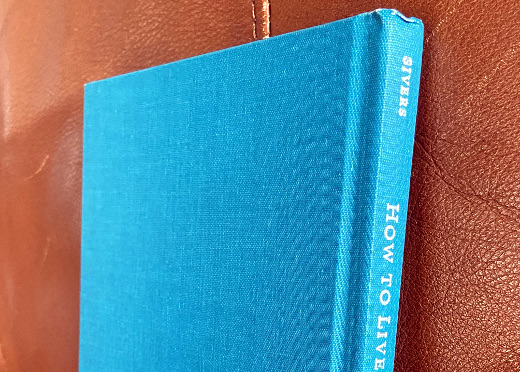
If you were to ask different people a question – any question really – you would likely get different answers. Why? The answers would be based on, at a minimum, the knowledge and philosophy of that person. As no two people are quite the same, this would apply to their thinking and response to your questions.
Continuing this logic, if you were to ask one person a single question, you would expect only one answer. Right? One, not 27. The multitude of answers to one particular question, how to live, is the premise of the book aptly titled, How to Live by Derek Sivers.
Sivers is a serial entrepreneur, author and musician whom many people know as the creator of CD Baby. I have been following him and his blog for years, where he shares his opinions on business, tech and life, especially as he has lived in many countries around the world. When How to Live came out, I was intrigued by the topic and picked up a copy from his Web site as he self-published and self-distributed the book.
With a subtitle of “27 conflicting answers and one weird conclusion” the book lives up to it, with thorough, well thought-out answers that range in extremes from “do nothing” to “make change” to everything in between. As I read through the answers, I had many takeaways from the book.
It’s good to see things from multiple points of views – This is something that I have recollections of, where I saw all sides of an issue and was able to work a situation to my advantage. On the flip side, there were times I didn’t see an issue from all sides and it came back to bite me or worse yet be an opportunity that slipped away.
The impact of change is relative – When I moved from Boston to Chicago, a friend opined I must have great courage to up and move as I did. I chuckled and responded that it wasn’t courage as much as a desire for a change of scenery, something both my wife and I sought out in our quest to the US Midwest. As I read through the answers in this book, I thought of this and even did a rough measurement of what the impact of might actually be of the answers.
Seek advice but make it your own – I recall a certain comedian/actor known for promoting a certain brand of pudding snacks once saying that when you give someone advice it is now theirs, and what they do with it is up to them and not on you the giver. In all of the answers in How to Live it provides a plethora of suggestions for what you can do, though likely you wouldn’t follow each to the letter.
How to Live is a short (~120 pages), quick and enjoyable read, and one that will get you thinking. Thinking not only of options of how to live your life, but the effort and thought process that went into writing such a book. It’s a good book for anyone to read from teens to well-beyond-teens. As I share all books, I am leaving this at Stateview Commons, the co-working space I currently work from. Perhaps one of my fellow co-workers will find it as interesting as well.
This is from The Hot Iron, a journal on business and technology by Mike Maddaloni.
Did you enjoy this? Subscribe to The Hot Iron by RSS/XML feed or Read by Email
Book Take-Aways • (0) Comments • PermalinkMy Takeaways From You Are Here For Now

For most people, where we are today is not where we were just a few years ago. For most, it is a state of mind, and a mind processing things we could have never anticipated. For some, they are physically in a different place, moving as a result of lockdowns and other personal reasons.
If I had a nickel for every time I heard – or said myself – that life is a journey, I would be on the beach right now and not gazing out at snow outside my window, but I digress. For as repetitive as it sounds, at least I need to keep hearing it, especially as a reminder when things are not going well or just outright suck.
In my mind, one of the best to say this is Adam J. Kurtz. He is the creative mind behind 1 Page At a Time and Things Are What You Make Them. Both are books to get you to think and the former is chock full of creative prompts. I am a big fan of AdamJK (for short), and when it was announced last year I pre-ordered his latest book, You Are Here *For Now.
You Are Here *For Now is a collection of short essays, quotes and art. Where at first glance it can be thought of as a self-help guide, I see it more of notes from a friend who is trying to help you go through the same crap as you are. As I have insightful family and friends that I am always taking away advice from, I have takeaways from this book too.
Pause – This is something this short-fused, 100% Italian-American needs to a lot more of. Maybe that pause is a deep breath or a walk along Lake Michigan (a favorite of mine when I lived in Chicago) or whatever works for you. A pause gives you time to think, get your heart rate down a little, and be more prepared for what you now have to deal with.
Hard But Not Impossible – Life is hard, sure, but not always impossible. In a world where waiting 30 seconds for food to heat in the microwave seems like an eternity, we need to adjust our thinking to better approach the hard work needed. The quotes and pictures in this book are a nice departure from simply a text narrative trying to motivate us.
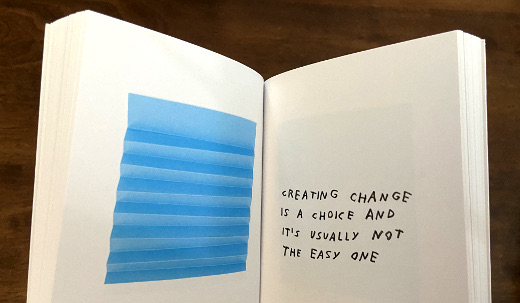
It Won’t Last – Yes, Virginia, there is a light at the end of the tunnel, and what we’re going through right now will come to an end. Granted what’s next could even be worse, or it could be better. We’ll never know until we get there.
You Are Here *For Now is a pocket-sized book and one where you can easily rip out the pages and hang them up or give them to others. As a fan of AdamJK’s work, it should come as no surprise that I recommend you to pick up a copy of this book. Because I pre-ordered the book, I got this “Find Your Way” stationary kit, pictured below. Click on the picture or this link to see the photo of the kit full-sized. I wish when I was in college I had an eraser that was inscribed with, “I literally don’t know what I am doing!”
As I give away all books I read, including this one, I have earmarked it for Matt, a long-time reader and commenter here at The Hot Iron. I will send it to him as soon as he contacts me and tells me the best address to send it to.
This is from The Hot Iron, a journal on business and technology by Mike Maddaloni.
Did you enjoy this? Subscribe to The Hot Iron by RSS/XML feed or Read by Email
Book Take-Aways • (0) Comments • Permalink
